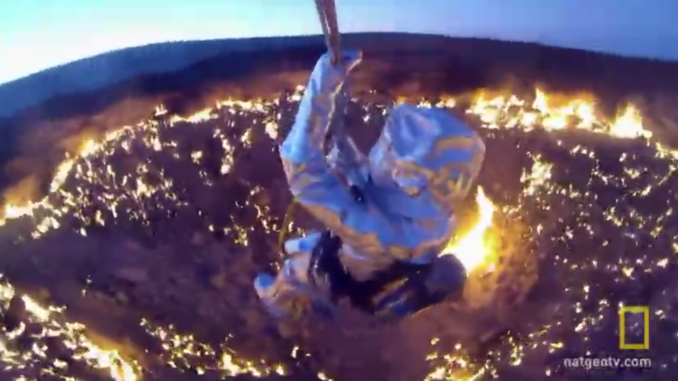
Darvaza was a small village of a few hundred souls located in the Karakum Desert in central Turkmenistan. Referring to the nearby Darvaza Gas Crater, the semi-nomadic locals call it “The Door to Hell” or “The Gates of Hell”, although this is probably more for the sake of promoting tourism than out of bonafide belief. (Curiously, the word darvaza [ دروازه ] comes from Persian and actually translates as “the gate” – make of that what you will). At any rate, in 2004, the village of Darvaza was ordered by the President of Turkmenistan to be vacated and leveled because he believed it was an unpleasant eyesore that would be a turn-off for tourists. Despite possessing one of the largest reserves of natural gas in the world, tourism is apparently where the priorities of the Turkmenistan government really lay. But back to our story…
In 1971, Soviet geologist were exploring for fossil fuels and believed a large oil field lay under the desert near Darvaza in the Turkmen Soviet Socialist Republic. They experienced the misfortune of drilling directly above an underground cavern filled with natural gas. The roof of the cavern gave way under the weight of the drilling rig, and the ground fell out from under their equipment. According to Soviet and Turkmen records of the accident (which range from sparse to non-existent) no one was injured by the collapse, which left a crater about 230-feet wide by 65-feet deep. Natural gas began seeping out of the crater immediately. Note that natural gas is comprised mainly of methane, which if present in the air and reaches or exceeds 5%, it poses a risk of explosion or suffocation. The geologist on site, fearing great loss of life to the local human population and wildlife, set the natural gas emanating from the crater on fire, expecting it to burn itself out when the underground gas reserve was depleted, which they estimated would be only a few weeks. Fifty years later, the Darvaza Gas Crater still burns with no indication of ending anytime soon.
Night versus day “[4K Drone] Darvaza Gas Crater (The Door to Hell) Turkmenistan” (3:08, but only the first two minutes are relevant):
Tourists to the site were relatively rare, until a television show made the remote crater world-famous. In 2013, in cooperation with National Geographic, Canadian George Kourounis, a television presenter, host of “Angry Planet”, storm chaser, and self-proclaimed professional adventurer, donned a fire-resistant suit and descended into the crater. At the bottom, he collected samples for scientific study which revealed that extremophile bacteria live in the depths of the burning pit. Rather than surviving by photosynthesis, they survive by chemosynthesis. Kourounis holds the Guinness World Record for being the first (and only) known human to ever venture down into the Darvaza Gas Crater, where temperatures are as high as 700°F.
“Flying Over Fire | Die Trying | National Geographic UK” (2:00):
Question of the Night: What is the most adventure you have found yourself in that, in retrospect, was risky or dangerous?
